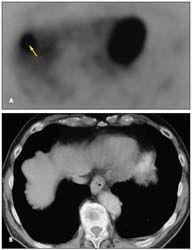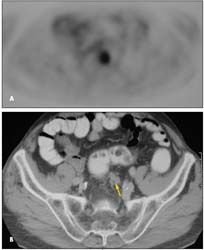- Clinical Technology
- Adult Immunization
- Hepatology
- Pediatric Immunization
- Screening
- Psychiatry
- Allergy
- Women's Health
- Cardiology
- Pediatrics
- Dermatology
- Endocrinology
- Pain Management
- Gastroenterology
- Infectious Disease
- Obesity Medicine
- Rheumatology
- Nephrology
- Neurology
- Pulmonology
Man With Recently Diagnosed Colon Cancer
A 56-year-old man comes to see you2 weeks after an emergency departmentvisit for GI bleeding, which resultedin a diagnosis of colon cancer.Endoscopy revealed a lesion in theproximal sigmoid colon that wasfound on biopsy to be a primary adenocarcinoma.A CT scan of the abdomenand pelvis that was performedto stage the lesion showed a liverlesion suggestive of metastatic diseasebut no evidence of extrahepaticdisease.
A 56-year-old man comes to see you 2 weeks after an emergency department visit for GI bleeding, which resulted in a diagnosis of colon cancer. Endoscopy revealed a lesion in the proximal sigmoid colon that was found on biopsy to be a primary adenocarcinoma. A CT scan of the abdomen and pelvis that was performed to stage the lesion showed a liver lesion suggestive of metastatic disease but no evidence of extrahepatic disease.

Click to Enlarge
The history is noncontributory. Temperature is 37.2°C (99°F); heart rate, 86 beats per minute with normal rhythm; respiration rate, 21 breaths per minute; and blood pressure, 136/84 mm Hg. Lungs are clear. Abdomen is soft and nontender, with normal bowel sounds.
The patient has done some research into possible treatments, and he wonders whether wedge resection of the liver lesion or radiofrequency ablation of the lesion with ultrasound guidance would be appropriate.
What diagnostic test will provide additional staging information and clarify whether one of these procedures can be used as definitive therapy?
WHICH TEST-AND WHY: In the United States, about 146,000 new cases of colorectal cancer are diagnosed each year; of these, approximately 56,000 will be fatal. However, mortality from colon cancer has been decreasing for the past 15 years as a result of earlier diagnosis and improved therapy.
Once colon cancer has been diagnosed, the next step is staging to guide therapy. Typically, a CT scan is ordered. Several studies have shown that fluorodeoxyglucose (FDG)–positron emission tomography (PET) scanning can also play an important role in the staging of primary adenocarcinoma of the colon and in the restaging of recurrent disease.

Click to Enlarge
Advantages of PET. Ogunbiyi and colleagues1 demonstrated that the sensitivity and specificity of FDGPET were 91% and 100%, respectively, for the detection of local pelvic recurrence, and 95% and 100%, respectively, for hepatic metastases. These percentages were higher than those associated with CT (sensitivity and specificity of 52% and 80%, respectively, for the detection of pelvic recurrence; 74% and 85%, respectively, for hepatic metastases).
Staib and associates2 found that in the setting of colorectal cancer, PET was 98% sensitive and 90% specific and had an accuracy of 95% for malignant findings, while CT was 91% sensitive, 72% specific, and 82% accurate.
PET is more sensitive and specific for colon cancer because it detects changes in the metabolic rate of cells rather than anatomic change. Cancer cells have a faster metabolic rate than normal cells; thus, they take up more FDG (radiolabeled sugar). Metabolic differences are often easier to detect than anatomic differences, and they are less often falsely positive.

Click to Enlarge
When to order PET. CT is usually ordered initially because it is available immediately almost everywhere. CT is also somewhat less expensive than PET.
Order PET if it is possible that the new information obtained could change the management approach. If the CT scan shows widespread metastatic disease, PET scan results are unlikely to affect treatment. However, if the CT scan shows localized disease or no spread of disease, a PET scan can be useful. Because it can detect metastases missed on CT, it can be helpful in restaging cancer.
It is possible that this patient may have more widespread disease than is evident on the CT scan; thus, you order a PET scan.
What the scan shows
. One PET image shows a lesion in the inferior aspect of the medial segment of the left lobe of the liver, which is also visible on the corresponding CT image (
Figure 1
).
Another PET image reveals a lesion within the dome of the liver in the most superior aspect of the anterior segment of the right lobe; this lesion is not seen on the corresponding CT image (
Figure 2
).
A third PET image shows adenopathy in the superior aspect of the pelvis posteriorly, which is consistent with extrahepatic metastatic disease; no adenopathy was appreciated at first in the corresponding CT image; however, it was identified retrospectively (
Figure 3
).
The final diagnosis is primary adenocarcinoma of the sigmoid colon with metastatic disease at 2 sites in the liver and extrahepatic metastatic disease. These results make it clear that neither wedge resection of the liver lesion nor radiofrequency ablation would constitute sufficient therapy. Instead, the treatment plan will include chemotherapy.
References:
REFERENCES:
1
. Ogunbiyi OA, Flanagan FL, Dehdashti F, et al. Detection of recurrent andmetastatic colorectal cancer: comparison of positron emission tomography andcomputed tomography.
Ann Surg Oncol.
1997;4:613-620.
2
. Staib L, Schirrmeister H, Reske SN, Beger HG. Is (18)F fluorodeoxyglucosepositron emission tomography in recurrent colorectal cancer a contribution tosurgical decision making?
Am J Surg.
2000;180:1-5.
